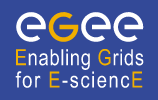|
The courses in the EGEE project
EGEE induction courses
An induction course has the target of
bringing new people in as EGEE participants or users. The majority will be new
recruits to the EGEE-II project; they will all be new users.
Induction training material includes how
to become a registered user of EGEE, the simple use, via portals, of established
facilities run by EGEE-II, and Virtual Organisations (VOs). It also includes
good real-world examples, and provides motivation for persevering with what can
be a difficult technology. This uses the GILDA/GENIUS t-Infrastructure.
Induction includes an introduction to
the further courses: e.g. the courses for application developers who then know
how to integrate applications with EGEE-II infrastructure and deploy them.
Three different subclasses of user
induction must meet the requirements of numbers trained, timeliness and quality.
-
EGEE Member Induction:
for EGEE team members to be oriented and
prepared to be effective in EGEE-II (New hires and old hands).
-
Grid-Aware Induction:
for users already Grid-aware to be inducted
to be EGEE users.
-
New Grid User Induction: for users who are Grid-naïve to be
inducted to be EGEE users. Induction courses linked to project conferences and
user forums are particularly popular and highly visible.
The induction material was re-used and
updated in many courses. It was also produced and delivered in languages other
than English.
Application developer training courses
An application developer is a person who
can be external to EGEE-II or be within EGEE-II, but who intends to build new
applications that:
The training assumes
expert levels of programming in an application domain, but does not necessarily
assume prior experience of Grids or Web Services.
An application-developer training course
develops the necessary understanding of the computational context provided by
the EGEE-II platform. It acquaints the developer with the commonly used
functions of that platform and their APIs. Participants will also learn of the
constraints on applications and on users, and the tools available for monitoring
and debugging operational applications.
The increasing functionality and
resources of the operational EGEE systems and the growing diversity of user
communities from more and more disciplines guarantee that demand for developer
courses will significantly increase.
Advanced courses
Participants on an advanced course will
already be experienced users of Grid-based systems such as EGEE, and will have
developed applications services, helped to establish new virtual organisations
or have engaged in supporting EGEE site operation. In other words they will be
well experienced in the underlying technology, its management and use.
Typically, their knowledge and skills will be at least on a par with someone who
has completed an application developer course and reinforced this with several
months of intensive work developing and using applications in the context of the
EGEE platform. We now recognise that there is a separate contingent of
operations staff who require advanced courses on middleware installation and
site management.
They will come to such courses expecting
to work intensively to acquire advanced knowledge and skills in a specific
technological area: e.g. fabric management, system administration, job
submission, workload management or scheduling. Another example might be
large-scale data management and data integration. This type of course will
require input from imported experts.
The aim is that after such a course the
group of developers would be able to build better applications and systems
infrastructure in the area on which the course was focussed. They should act as
effective advocates for the benefits of using EGEE infrastructure as an
environment for applications. Many will also become important well-informed
sources of requirements input to the design of future EGEE platform
releases.
|

